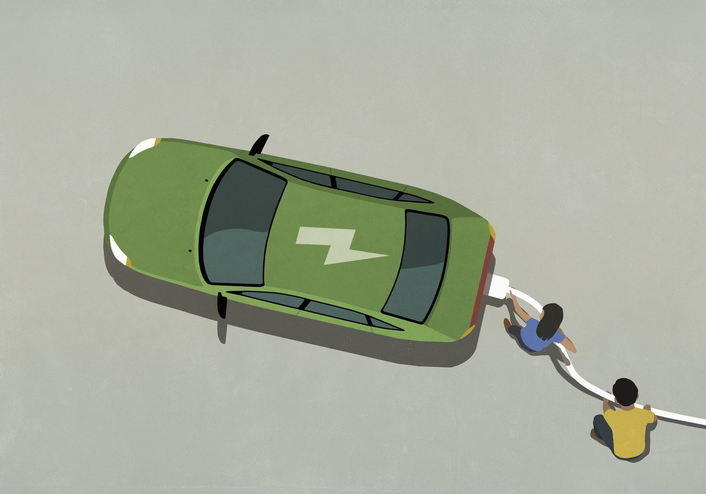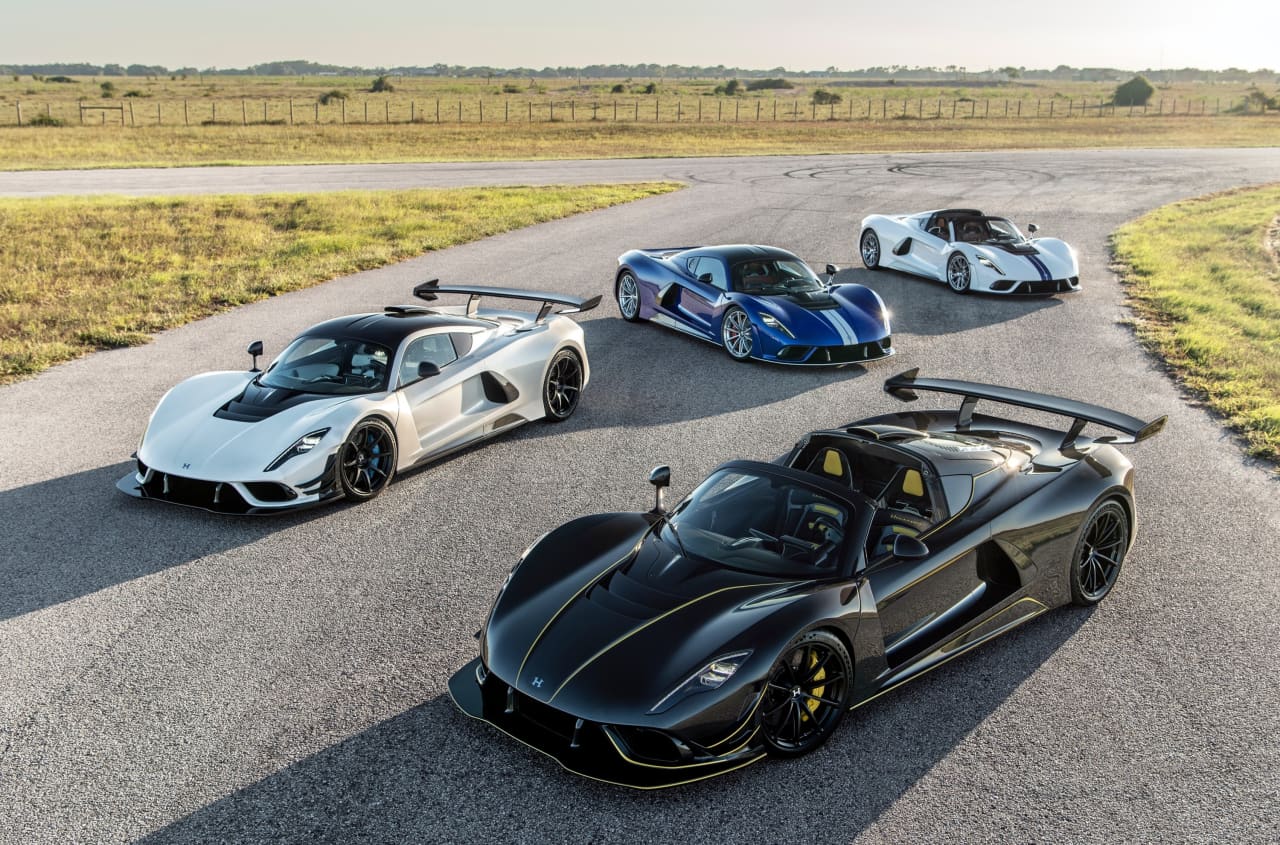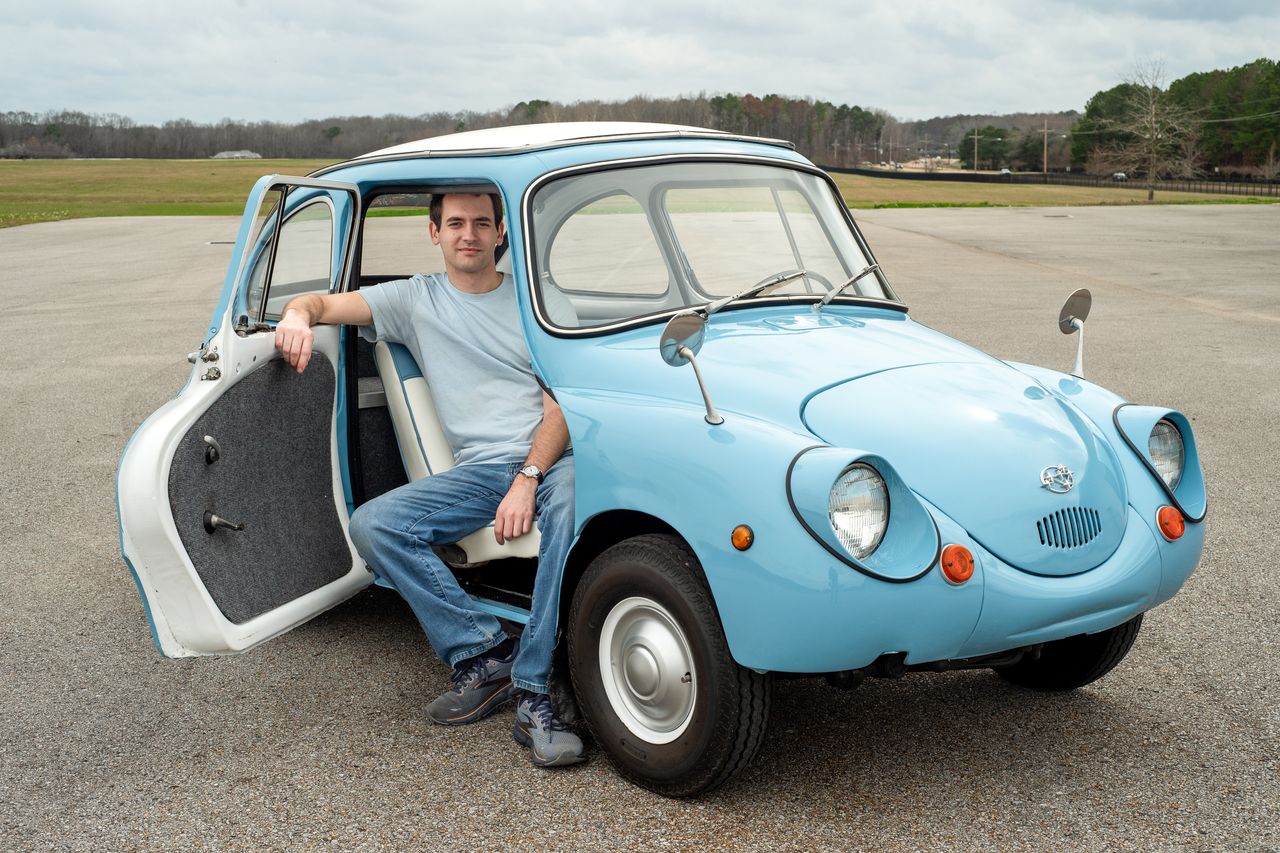Electric Cars and Driving Range: Here’s What to Know
How far can an electric car really go on a full charge? What can you do to make it go farther? We answer these and other questions that EV buyers might ask.
Many people considering an electric vehicle are turned off by their prices or the paucity of public charging stations. But the biggest roadblock often is “range anxiety”—the fear of getting stuck on a desolate road with a dead battery.
All EVs carry window stickers stating how far they should go on a full charge. Yet these range estimates—overseen by the Environmental Protection Agency and touted in carmakers’ ads—can be wrong in either direction: either overstating or understating the distance that can be driven, sometimes by 25% or more.
How can that be? Below are questions and answers about how driving ranges are calculated, what factors affect the range, and things EV owners can do to go farther on a charge.
How far will an electric vehicle go on a full battery?
The distance, according to EPA testing, ranges from 516 miles for the 2023 Lucid Air Grand Touring with 19-inch wheels to 100 miles for the 2023 Mazda MX-30.
Most EVs are in the 200-to-300-mile range. While that is less than the distance that many gasoline-engine cars can go on a full tank, it makes them suitable for most people’s daily driving and medium-size trips. Yet it can complicate longer journeys, especially since public chargers can be far apart, occupied or out of service. Plus, it takes many times longer to charge an EV than to fill a tank with gas.
How accurate are the EPA range estimates?
Testing by Car and Driver magazine found that few vehicles go as far as the EPA stickers say. On average, the distance was 12.5% shorter, according to the peer-reviewed study distributed by SAE International, formerly the Society of Automotive Engineers.
In some cases, the estimates were further off: The driving range of Teslas fell below their EPA estimate by 26% on average, the greatest shortfall of any EV brand the magazine tested. Separately, federal prosecutors have sought information about the driving range of Teslas, The Wall Street Journal reported. Tesla didn’t respond to a request for comment.
The study also said Ford’s F-150 Lightning pickup truck went 230 miles compared with the EPA’s 300-mile estimate, while the Chevrolet Bolt EV went 220 miles versus the EPA’s 259.
A GM spokesman said that “actual range may vary based on several factors, including things like temperature, terrain/road type, battery age, loading, use and maintenance.” Ford said in a statement that “the EPA [figure] is a standard. Real-world range is affected by many factors, including driving style, weather, temperature and if the battery has been preconditioned.”
Meanwhile, testing by the car-shopping site Edmunds found that most vehicles beat their EPA estimates. It said the Ford Lightning went 332 miles on a charge, while the Chevy Bolt went 265 miles.
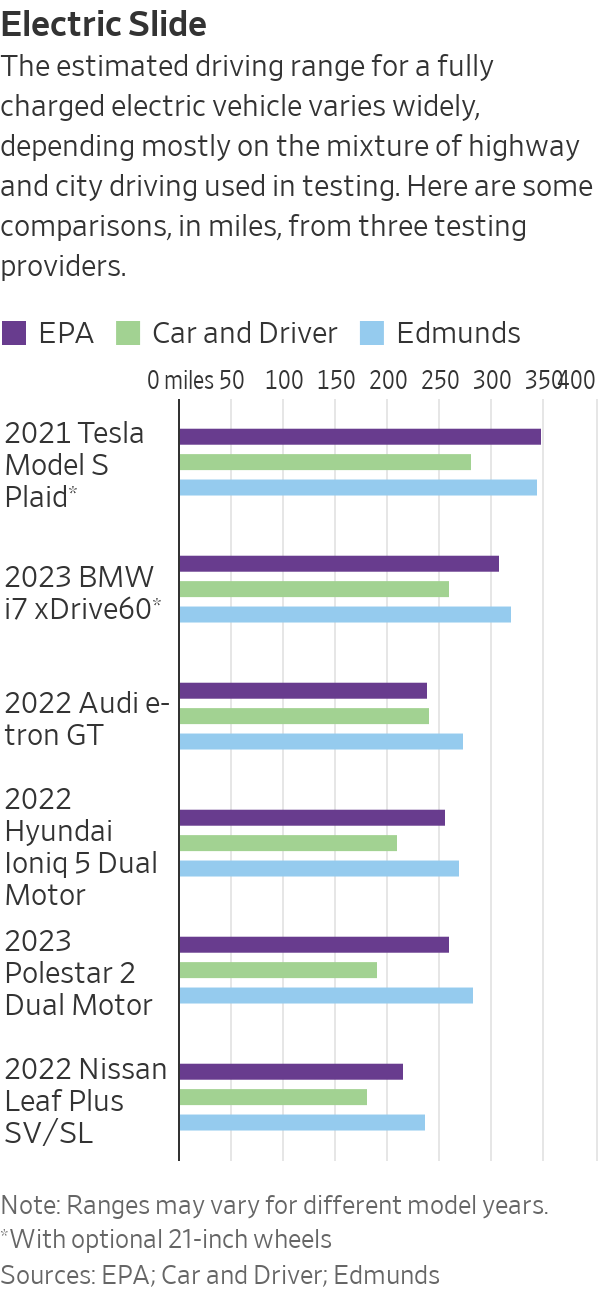
That is confusing. How can the test results vary so much?
Driving range depends largely on the mixture of highway and city roads used for testing. Unlike gasoline-powered cars, EVs are more efficient in stop-and-go driving because slowing down recharges their batteries through a process called regenerative braking. Conversely, traveling at a high speed can eat up a battery’s power faster, while many gas-engine cars meet or exceed their EPA highway miles-per-gallon figure.
What types of driving situations do the various tests use?
Car and Driver uses only highway driving to see how far an EV will go at a steady 75 mph before running out of juice. Edmunds uses a mix of 60% city driving and 40% highway. The EPA test, performed on a treadmill, simulates a mixture of 55% highway driving and 45% city streets.
What’s the reasoning behind the different testing methods?
Edmunds believes the high proportion of city driving it uses is more representative of typical EV owners, says Jonathan Elfalan, Edmunds’s director of vehicle testing. “Most of the driving [in an EV] isn’t going to be road-tripping but driving around town,” he says.
Car and Driver, conversely, says its all-highway testing is deliberately more taxing than the EPA method. High-speed interstate driving “really isn’t covered by the EPA’s methodology,” says Dave VanderWerp, the magazine’s testing director. “Even for people driving modest highway commutes, we think they’d want to know that their car could get 20%-30% less range than stated on the window sticker.”
What does the EPA say about the accuracy of its range figures?
The agency declined to make a representative available to comment, but said in a statement: “Just like there are variations in EPA’s fuel-economy label [for gas-engine cars] and people’s actual experience on the road for a given make and model of cars/SUVs, BEV [battery electric vehicle] range can exceed or fall short of the label value.”
What should an EV shopper do with these contradictory range estimates?
Pick the one based on the testing method that you think matches how you generally will drive, highway versus city. When shopping for a car, be sure to compare apples to apples—don’t, for instance, compare the EPA range estimate for one vehicle with the Edmunds one for another. And view all these figures with skepticism. The estimates are just that.
Since range is so important to many EV buyers, why don’t carmakers simply add more batteries to provide greater driving distance?
Batteries are heavy and are the most expensive component in an EV, making up some 30% of the overall vehicle cost. Adding more could cut into a vehicle’s profit margin while the added weight means yet more battery power would be used to move the car.
But battery costs have declined over the past 10 years and are expected to continue to fall, while new battery technologies likely will increase their storage capacity. Already, some of the newest EV models can store more power at similar sticker prices to older ones.
What can an EV owner do to increase driving range?
The easiest thing is to slow down. High speeds eat up battery life faster. Traveling at 80 miles an hour instead of 65 can cut the driving range by 17%, according to testing by Geotab, a Canadian transportation-data company. And though a primal appeal of EVs is their zippy takeoff, hard acceleration depletes a battery much quicker than gentle acceleration.
Does cold weather lower the driving range?
It does, and sometimes by a great amount. The batteries are used to heat the car’s interior—there is no engine creating heat as a byproduct as in a gasoline car. And many EVs also use electricity to heat the batteries themselves, since cold can deteriorate the chemical reaction that produces power.
Testing by Consumer Reports found that driving in 15- to-20-degrees Fahrenheit weather at 70 mph can reduce range by about 25% compared to similar-speed driving in 65 degrees.
A series of short cold-weather trips degraded the range even more. Consumer Reports drove two EVs 40 miles each in 20-degree air, then cooled them off before starting again on another 40-mile drive. The cold car interiors were warmed by the heater at the start of each of three such drives. The result: range dropped by about 50%.
Does air conditioning degrade range?
Testing by Consumer Reports and others has found that using the AC has a much lower impact on battery range than cold weather, though that effect seems to increase in heat above 85 degrees.
I don’t want to freeze or bake in my car to get more mileage. What can I do?
“Precondition” your EV before driving off, says Alex Knizek, manager of automotive testing and insights at Consumer Reports. In other words, chill or heat it while it is still plugged in to a charger at home or work rather than using battery power on the road to do so. In the winter, turn on the seat heaters, which many EVs have, so you be comfortable even if you keep the cabin temperature lower. In the summer, try to park in the shade.
What about the impact from driving in a mountainous area?
Going up hills takes more power, so yes, it drains the battery faster, though EVs have an advantage over gas vehicles in that braking on the downside of hills returns juice to the batteries with regenerative braking.
Are there other factors that can affect range?
Tires play a role. Beefy all-terrain tires can eat up more electricity than standard ones, as can larger-diameter ones. And underinflated tires create more rolling resistance, and so help drain the batteries.
Most EVs give the remaining driving range on a dashboard screen. Are these projections accurate?
The meters are supposed to take into account your speed, outside temperature and other factors to keep you apprised in real time of how much farther you can travel. But EV owners and car-magazine testers complain that these “distance to empty” gauges can suddenly drop precipitously if you go from urban driving to a high-speed highway, or enter mountainous territory.
So be careful about overly relying on these gauges and take advantage of opportunities to top off your battery during a multihour trip. These stops could be as short as 10 or 15 minutes during a bathroom or coffee break, if you can find a high-powered DC charger.
Before embarking on a long trip, what should an EV owner do?
Fully charge the car at home before departing. This sounds obvious but can be controversial, since many experts say that routinely charging past 80% of a battery’s capacity can shorten its life. But they also say that charging to 100% occasionally won’t do damage. Moreover, plan your charging stops in advance to ease the I-might-run-out panic.
So battery life is an issue with EVs, just as with smartphones?
Yes, an EV battery’s ability to fully charge will degrade with use and age, likely leading to shorter driving range. Living in a hot area also plays a role. The federal government requires an eight-year/100,000-mile warranty on EV batteries for serious failure, while some EV makers go further and cover degradation of charging capacity. Replacing a bad battery costs many thousands of dollars.
What tools are available to map out charging stations?
Your EV likely provides software on the navigation screen as well as a phone app that show charging stations. Google and Apple maps provide a similar service, as do apps and websites of charging-station networks.
But always have a backup stop in mind—you might arrive at a charging station and find that cars are lined up waiting or that some of the chargers are broken. Damaged or dysfunctional chargers have been a continuing issue for the industry.
Any more tips?
Be sure to carry a portable charger with you—as a last resort you could plug it into any 120-volt outlet to get a dribble of juice.
 Copyright 2020, Dow Jones & Company, Inc. All Rights Reserved Worldwide. LEARN MORE
Copyright 2020, Dow Jones & Company, Inc. All Rights Reserved Worldwide. LEARN MORE
This stylish family home combines a classic palette and finishes with a flexible floorplan
Just 55 minutes from Sydney, make this your creative getaway located in the majestic Hawkesbury region.
There are Corvette fans for whom the base US$68,300 car is plenty powerful enough. After all, it produces 495 horsepower and can reach 60 miles per hour in 2.9 seconds. But hold on, there’s also the approximately US$115,000 Z06—with 670 horsepower and able to reach 60 in 2.6 seconds. These split seconds are important for busy people—and for marketing claims. And if that’s not enough go power, there’s the even more formidable 900-horsepower ZR1 version of the Corvette, starting around US$150,000. The hybrid E-Ray, at US$104,900, is pretty potent, too.
But if they’re still too slow, fans of American-engineered muscle can consider the exclusive Texas-built Hennessey Venom F5, a limited-edition carbon-fibre hypercar. Ten years ago, the Hennessey became the world’s fastest production car, defeating the Bugatti Veyron Super Sport, with a top speed of 270.49 miles per hour.
That world title is much sought after, and is currently held by the Sweden-built 1,600-horsepower Koenigsegg Jesko Absolut, with a two-way average top speed of 277.8 mph. But Hennessey is still very much a contender. The company is hoping the 1,817-horsepower F5 (with 1,192 pound-feet of torque) can exceed 300 mph on the track this year.
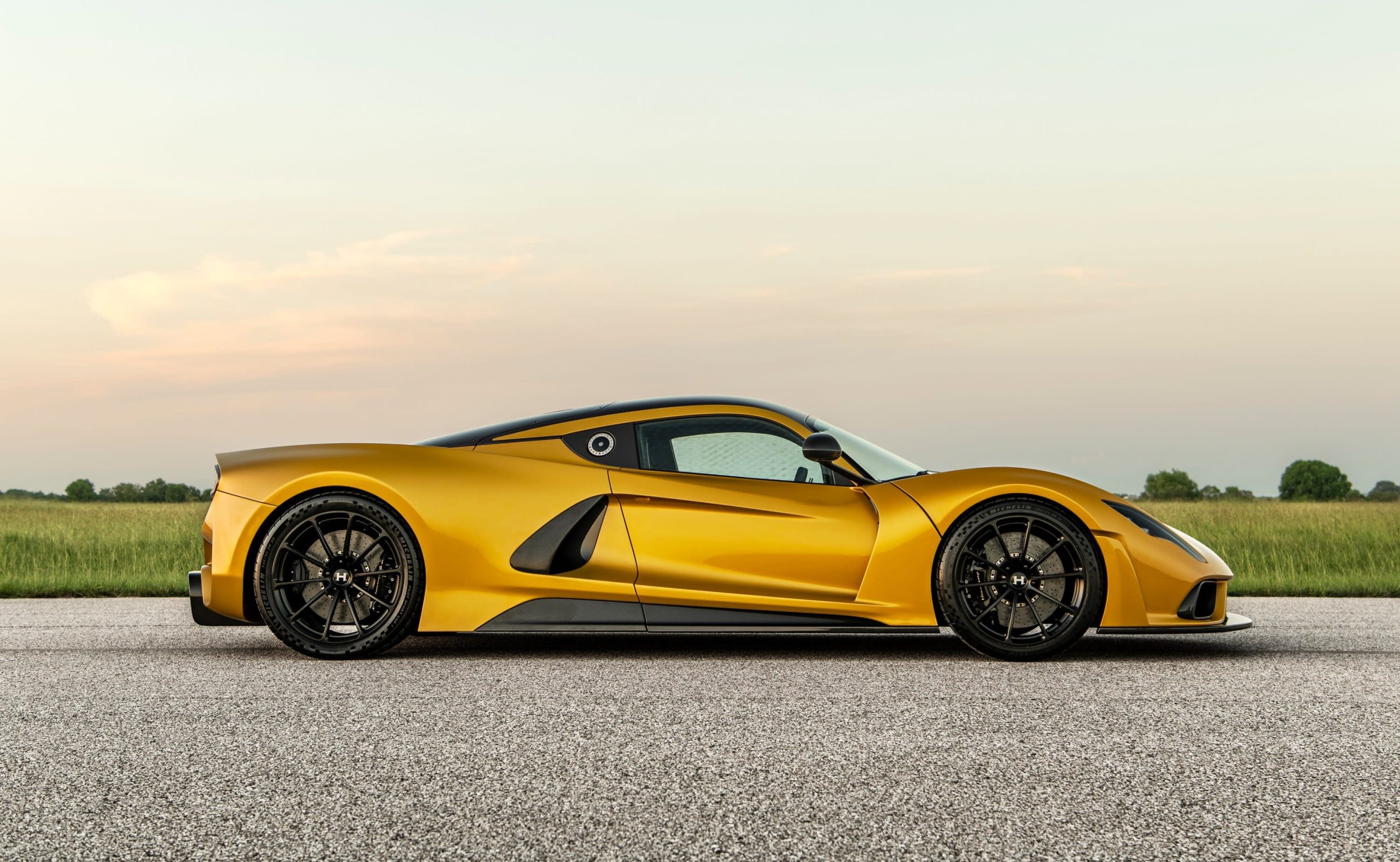
Hennessey photo
Hennessey’s previous Venom GT model (introduced in 2010) was based on the Lotus Exige, with a GM LS-based engine, and was built by partner Delta Motorsport. Spokesman Jon Visscher tells Penta , “The new Venom F5, revealed in 2020, is a 100%bespoke creation—unique to Hennessey and featuring a Hennessey-designed 6.6-litre twin-turbo V8 engine boasting 1,817 horsepower, making it the world’s most powerful combustion-engine production car.” Leaps in performance like this tend to be pricey.
This is a very exclusive automobile, priced around US$2.5 million for the coupe, and US$3 million for the F5 Roadster announced in 2023. Only 30 Roadsters will be built, with a removable carbon-fiber roof. The 24 F5 coupes were spoken for in 2021, but if you really want one you could find a used example—or go topless. In a statement to Penta , company founder and CEO John Hennessey said that while the coupe “is now sold out, a handful of build slots remain for our Roadster and [track-focused] Revolution models.”
Only 24 Revolutions will be built in coupe form, priced at US$2.7 million. There’s also a rarefied roadster version of the Revolution, with just 12 to be built.
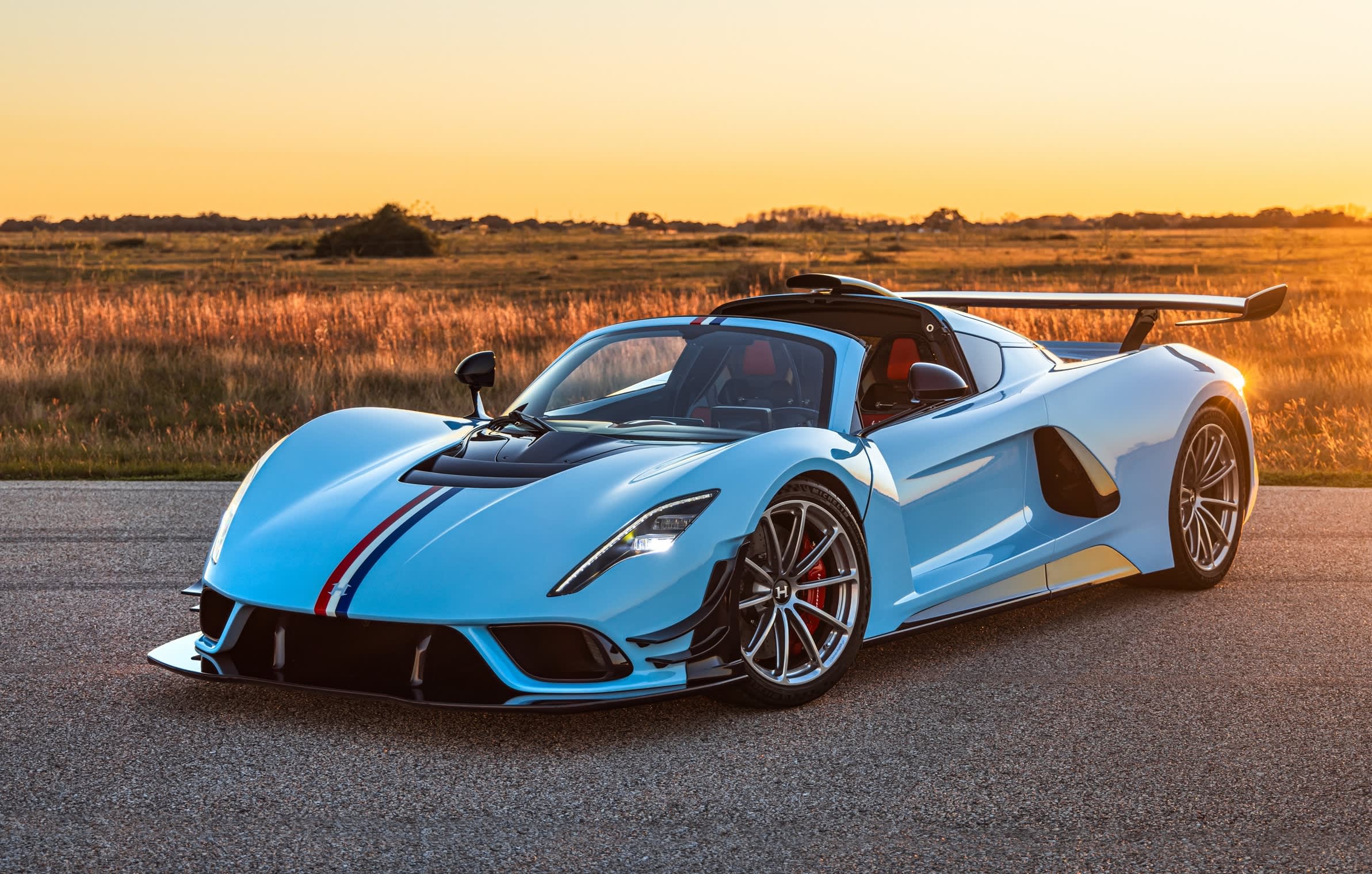
Hennessey photo
The Venom F5 coupe weighs only 3,000 pounds, and it’s not surprising that insane speeds are possible when combined with a hand-built motor (nicknamed “Fury”) created with power uppermost. The V8 in the F5, installed in a rear mid-engine configuration, has a custom engine block and lightweight forged aluminium pistons, billet-steel crankshaft, and forged-steel connecting rods. Twin turbochargers are featured. The F5 can reach 62 mph in less than three seconds, but top speed seems to be its claim to fame.
The driver shifts the rear-wheel-drive car via a seven-speed, single-clutch transmission with paddle shifters. The interior is not as spartan or as tight as in many other supercars, and is able to handle very tall people. The butterfly doors lift up for access.
“With 22 customer Venom F5 hypercars already delivered to customers around the world, and a newly expanded engineering team, we’re focusing the Venom F5 on delivering on its potential,” Hennessey says. “Breaking 300 mph in two directions is the goal we aim to achieve toward the end of this year to claim the ‘world’s fastest production car’ title.”
Hennessey says the car and team are ready. “Now the search is on for a runway or public road with a sufficiently long straight to allow our 1,817-horsepower, twin-turbo V8 monster to accelerate beyond 300 mph and return to zero safely.” The very competitive Hennessey said the track-focused Revolution version of the F5 set a fastest production car lap around Texas’ 3.41-mile Circuit of the Americas track in March, going almost seven seconds faster than a McLaren P1.
The Revolution features a roof-mounted central air scoop (to deliver cool air to the engine bay), a full-width rear carbon wing, larger front splitter and rear diffuser, tweaked suspension, and engine cooling. It’s got the same powertrain as the standard cars, but is enhanced to stay planted at otherworldly speeds.
This stylish family home combines a classic palette and finishes with a flexible floorplan
Just 55 minutes from Sydney, make this your creative getaway located in the majestic Hawkesbury region.









